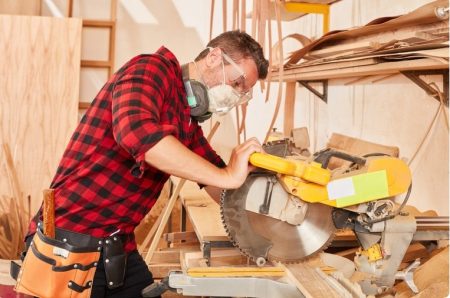Table of Contents
- Understanding Your 12-Inch Miter Saw
- Safety Equipment and Personal Protective Gear
- Workshop Setup and Organization
- Pre-Operation Checklist
- Safe Operation Techniques
- Dust Collection and Respiratory Health
- Handling Different Materials
- Common Safety Hazards and How to Avoid Them
- Emergency Procedures
- Maintenance and Blade Changing Safety
- Training and Education
- Conclusion
Woodworking can be a rewarding and creative pursuit, but it’s essential to prioritize safety, especially when using power tools like a 12-inch miter saw. This guide will walk you through the critical safety precautions and measures to ensure your well-being while making precise cuts with your miter saw.
Understanding Your 12-Inch Miter Saw
Before delving into safety measures, it’s crucial to understand the tool itself. A 12-inch miter saw typically consists of a sharp circular blade mounted on a pivoting arm. It allows for precise angle and miter cuts, making it a versatile tool in woodworking projects.
Safety Equipment and Personal Protective Gear
Essential Safety Equipment
- Safety Glasses: Protect your eyes from flying debris or dust.
- Hearing Protection: Guard against the noise generated by the saw.
- Dust Mask: Prevent inhalation of fine wood particles.
- Appropriate Clothing: Wear fitted, non-loose clothing and closed-toe shoes for added safety.
Workshop Setup and Organization
A clean, well-organized workshop is essential for safety. Ensure good lighting and clear pathways to move around comfortably. Remove clutter and keep the workspace free of obstructions.
Pre-Operation Checklist
Before you start your miter saw, perform a thorough pre-operation check:
- Inspect the saw for any visible damage or loose parts.
- Ensure the saw is placed on a stable and level work surface.
- Verify that safety features such as blade guards and triggers are functioning correctly.
Safe Operation Techniques
Body Stance
Maintain a firm and balanced stance while operating the saw. Stand to the side, not directly in line with the blade’s path. Keep your body weight evenly distributed.
Secure the Workpiece
Use clamps or a vise to secure the workpiece firmly in place. This prevents it from moving or kicking back during cutting.

Dust Collection and Respiratory Health
Miter saws produce a significant amount of sawdust. To protect your respiratory health:
- Invest in a dust collection system or use a shop vacuum with a dust port.
- Always wear a dust mask to filter out fine particles.
Handling Different Materials
Each material presents unique safety considerations:
- Wood: Beware of knots, nails, and hidden defects.
- Plastic: Ensure materials are securely clamped to prevent warping.
- Metal: Use appropriate blades and lubricants for metal cutting.
Common Safety Hazards and How to Avoid Them
Kickback
To avoid kickback, maintain a firm grip on the saw and workpiece. Keep hands away from the blade’s path.
Blade Binding
Blade binding can occur when the saw binds in the workpiece. Release the trigger immediately if this happens.
Emergency Procedures
In case of an accident or malfunction:
- Turn off the saw and disconnect it from power.
- Administer first aid if necessary and seek medical attention for injuries.
- Address any issues with the saw before resuming work.
Maintenance and Blade Changing Safety
When performing maintenance or changing the blade:
- Always disconnect the saw from power.
- Follow manufacturer instructions for blade changes and maintenance tasks.
Training and Education
Proper training and education are invaluable for safe miter saw use. Consider enrolling in woodworking courses or seeking guidance from experienced woodworkers. Sharing safety knowledge with others is equally essential.
Conclusion
By prioritizing safety and following these key precautions, you can enjoy your woodworking projects with confidence. Remember, safety should always come first. Stay vigilant, use the right safety gear, and take the necessary steps to protect yourself while making precise cuts with your 12-inch miter saw.